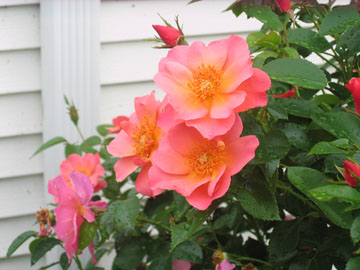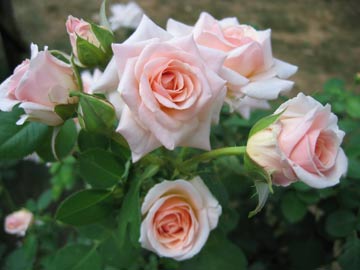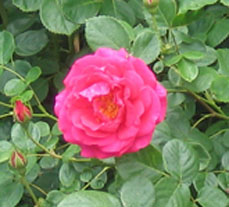"All the Rage"
 |
Sustainability has become the new buzzword for everything from gardening to the economy. We hear in the news and in the political arena the phrases sustainable jobs, sustainable automobiles, and sustainable agriculture. As rose gardeners, we’re in luck because what we have in greater numbers than ever are sustainable roses.
Mike and I have been extolling the benefits of sustainable roses for almost a decade when we started to move away from the exhibition hybrid teas that require an aggressive spray program. We still exhibit roses, but most of our entries are in the shrub classes because shrubs, as well as hardy floribundas, are what we now grow except for a few favorite hybrid tea and grandiflora varieties that remain in our older rose garden. When the ‘Au Natural’ class was introduced in our rose show two years ago, we had many sustainable varieties we could enter from the new “sustainable” rose garden planted in our front yard. The first year we won the class with ‘Playboy’ and the second year with ‘Rainbow Sorbet’. We credit winning the Au Natural class not because we have a magic touch, but because we had chosen to plant only sustainable varieties – roses that could be grown successfully without using chemical pesticides.
Sustainable rose gardening does not mean the same as organic rose gardening nor does it mean limiting ourselves to ‘EarthKind’ or ‘Easy Care’ roses. We are not organic gardeners, but we do follow basic horticultural practices that overlap organic gardening. For instance, we plant our rosebushes further apart in our sustainable garden than we do in our other garden that we regularly spray. We prune with the idea of consciously allowing more air circulation within and around our rose bushes. We introduced other plant species in our sustainable garden to avoid a monoculture that would encourage the development of rose-prone diseases and insects. In our other long-established garden we grow strictly roses. The thought of adding other species was never an option, (although we are now considering redesigning this garden and making it more sustainable). We regularly amend our soil with organics, water our roses copiously, and feed regularly, but these are gardening practices we advocate for any garden, sustainable or not.
While good horticultural practices are a must for any garden, the key to having a successful sustainable rose garden is in the selection of the right varieties. We do plenty of research, visit many public rose gardens, observe our own gardens, as well as the Victorian Rose Garden in Roger Williams Park, and make note of the varieties that grow well with no chemical pesticides. However, what we have learned, through our observations and our roles as consultants for the Chet Clayton Sustainable Rose Garden at the University of Rhode Island, is that what is sustainable in one garden may not be sustainable in other gardens.
We saw this in the Chet Clayton Garden where ‘Zephirine Droughin’, which has a reputation for high disease-resistance, performed poorly and developed a bad case of powdery mildew halfway through the first season. We removed all the plants of ‘Zephine Droughin’, replacing them with ‘New Dawn’. Volunteers who work in the garden took the defoliated roses and planted them in their own gardens where they are now reported to be growing disease free!
The phrase “a rose garden is a work in progress” definitely refers to the development of a sustainable garden. While most of the sustainable roses we planted in our home’s front garden have performed well, we have had some disappointments. The ‘Playboy’ that won the first Au Natural best of class in the 2007 RIRS Rose Show developed a severe case of blackspot later in the season, and we decided it wasn’t sustainable enough to remain. ‘Rainbow Sorbet’ grew in our garden for two seasons and then we removed it because, although it had a very clean first bloom cycle, by mid-July it had too much blackspot and we did not want it to infect the healthy plants on either side of it.
We evaluate our roses at the end of each season based on a set of sustainable standards we developed. It goes without saying that the first criterion is winter-hardiness and we plant only those varieties that are. In our very sunny sustainable garden, in addition to being zone-appropriate, the varieties we plant must tolerate the intense direct sunlight and heat of mid-summer. Sadly, mauve roses don’t tolerate the kind of heat that our garden receives in mid-July through August. That is why when the blooms on the two plants of ‘Rhapsody in Blue’, planted on either side of our front steps, burned and shattered with the first heat wave of the summer, we replaced them with ‘Super Hero’ and ‘Macy’s Pride’. (We already know that ‘Super Hero’ is sustainable in our garden and we will know next season how ‘Macy’s Pride’ performs.)10
Some Reliably Sustainable Varieties Include:
All the Rage
Baby Love
Bonica
Crimson Mediland
Home Run
Kiss Me
Knock Out
Lady Elsie May
My Girl
My Hero
Pretty Lady
Yellow Brick Road
Yellow Submarine
Our second criterion for sustainability is  that varieties don’t have to be disease-free; they have to be disease-resistant and able to thrive without the use of chemical pesticides. If a variety has a little blackspot, a little powdery mildew, or a few nibbled leaves it doesn’t get banished automatically. However, if it has more blackspot than not, it may get replaced sooner rather than later depending on its ongoing performance. This was the case with a favorite rose, ‘Julia Child’. After a floriferous and healthy first June bloom, it developed a severe infection of blackspot and many of its leaves dropped. It recovered in time for a mediocre third bloom. We gave it a second and then a third season and finally removed it from its prime location in the garden. We may give Julia another try elsewhere, considering that it is performing well in the Clayton Rose Garden. that varieties don’t have to be disease-free; they have to be disease-resistant and able to thrive without the use of chemical pesticides. If a variety has a little blackspot, a little powdery mildew, or a few nibbled leaves it doesn’t get banished automatically. However, if it has more blackspot than not, it may get replaced sooner rather than later depending on its ongoing performance. This was the case with a favorite rose, ‘Julia Child’. After a floriferous and healthy first June bloom, it developed a severe infection of blackspot and many of its leaves dropped. It recovered in time for a mediocre third bloom. We gave it a second and then a third season and finally removed it from its prime location in the garden. We may give Julia another try elsewhere, considering that it is performing well in the Clayton Rose Garden.
 Our third criterion is that the varieties we choose not only need to have a repeat-bloom, but have to bloom profusely. A bush that gives us a scant bloom isn’t worth the real estate it takes up in the garden – our space is too limited. We had planted ‘Moje Hammarberg’, a hybrid rugosa that showed no signs of disease but didn’t give us much of a show of blooms either. It was transplanted to join other rugosas planted along our back property line. Our third criterion is that the varieties we choose not only need to have a repeat-bloom, but have to bloom profusely. A bush that gives us a scant bloom isn’t worth the real estate it takes up in the garden – our space is too limited. We had planted ‘Moje Hammarberg’, a hybrid rugosa that showed no signs of disease but didn’t give us much of a show of blooms either. It was transplanted to join other rugosas planted along our back property line.
By practicing sustainable rose gardening we’re not looking for “No Care Roses” – roses we can plant and forget about like we do our forsythia bushes. What fun is that? For us rose gardening means planting and nurturing plants. Nurturing entails caring for roses which includes watering, feeding and pruning as well as dealing with insects and diseases. Sustainable rose gardening encompasses all that without the use of chemical pesticides.
In an era where we are concerned about the environment and going green is on everyone’s mind, the time for sustainable rose gardening has arrived and is, I believe, the future of rose gardening.
(Above left: ‘My Girl’; above right: ‘Pretty Lady’)
|


 that varieties don’t have to be disease-free; they have to be disease-resistant and able to thrive without the use of chemical pesticides. If a variety has a little blackspot, a little powdery mildew, or a few nibbled leaves it doesn’t get banished automatically. However, if it has more blackspot than not, it may get replaced sooner rather than later depending on its ongoing performance. This was the case with a favorite rose, ‘Julia Child’. After a floriferous and healthy first June bloom, it developed a severe infection of blackspot and many of its leaves dropped. It recovered in time for a mediocre third bloom. We gave it a second and then a third season and finally removed it from its prime location in the garden. We may give Julia another try elsewhere, considering that it is performing well in the Clayton Rose Garden.
that varieties don’t have to be disease-free; they have to be disease-resistant and able to thrive without the use of chemical pesticides. If a variety has a little blackspot, a little powdery mildew, or a few nibbled leaves it doesn’t get banished automatically. However, if it has more blackspot than not, it may get replaced sooner rather than later depending on its ongoing performance. This was the case with a favorite rose, ‘Julia Child’. After a floriferous and healthy first June bloom, it developed a severe infection of blackspot and many of its leaves dropped. It recovered in time for a mediocre third bloom. We gave it a second and then a third season and finally removed it from its prime location in the garden. We may give Julia another try elsewhere, considering that it is performing well in the Clayton Rose Garden. Our third criterion is that the varieties we choose not only need to have a repeat-bloom, but have to bloom profusely. A bush that gives us a scant bloom isn’t worth the real estate it takes up in the garden – our space is too limited. We had planted ‘Moje Hammarberg’, a hybrid rugosa that showed no signs of disease but didn’t give us much of a show of blooms either. It was transplanted to join other rugosas planted along our back property line.
Our third criterion is that the varieties we choose not only need to have a repeat-bloom, but have to bloom profusely. A bush that gives us a scant bloom isn’t worth the real estate it takes up in the garden – our space is too limited. We had planted ‘Moje Hammarberg’, a hybrid rugosa that showed no signs of disease but didn’t give us much of a show of blooms either. It was transplanted to join other rugosas planted along our back property line.